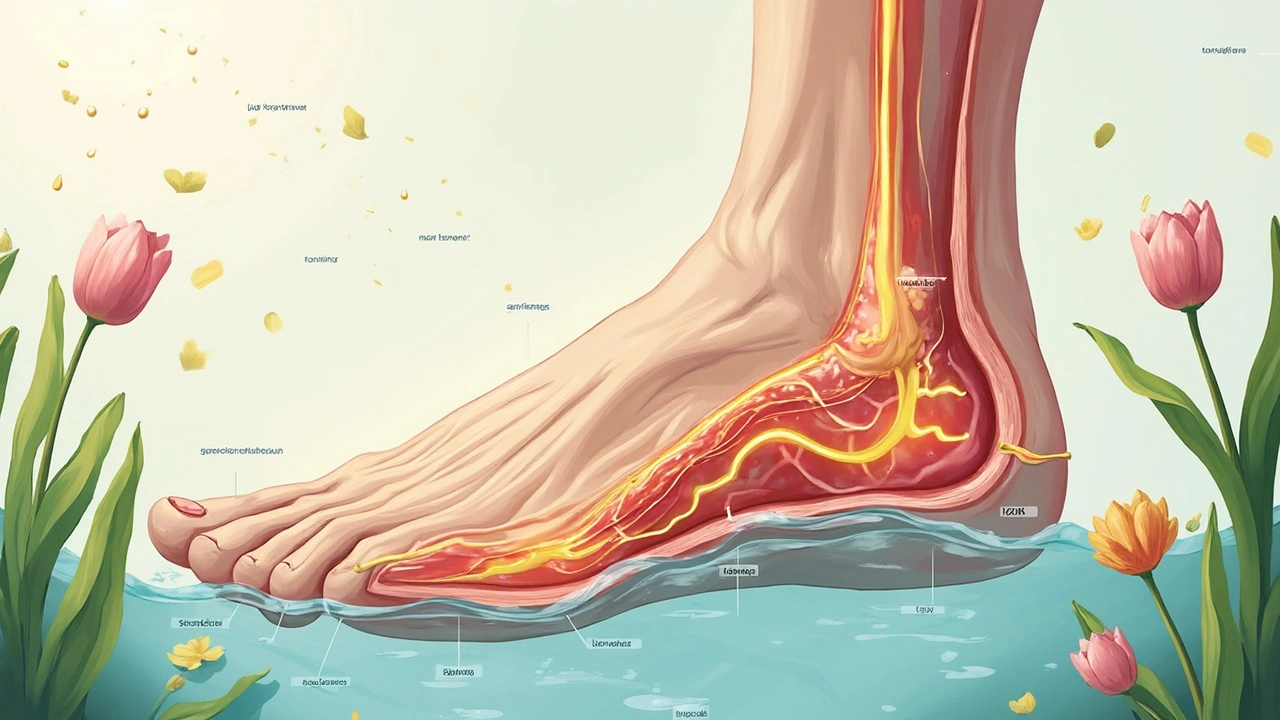Foot Massage for Detox: How It Works and Why You Should Try It

Your feet can tell you a lot about your health, but did you know they might even play a role in detoxification? Foot massage isn’t just about relaxing after a long, busy day—some folks believe it can actually help clear out the gunk your body builds up. If you’ve ever wondered if there’s something to the idea of "detoxing" your body through your feet, you’re in the right place.
The buzz around foot massage for detox keeps growing, but not everyone agrees on how it works or even if it does. What’s real and what’s just clever marketing? We’ll get straight to the details, so you're not left wondering or falling for hype. Ready to dig into what your feet can really do for your whole body?
- Quick Facts: Foot Massage and Detox
- The Science Behind Foot Massage and Body Detox
- Choosing Foot Massage Services Near You
- What Happens During a Foot Massage Session?
Quick Facts: Foot Massage and Detox
If you’ve got only a minute, here’s what you need to know about how foot massage connects to detox. There’s a bunch of chatter online about how rubbing your feet helps filter out bad stuff from your body, but let’s stick to what research and real experiences say.
- Foot massage (sometimes called reflexology) targets pressure points that, according to this technique, link to different organs—think liver, kidneys, even your gut.
- The main idea is that by stimulating these spots, you can help your body get rid of waste faster and feel more balanced.
- There’s no hard proof yet that a foot massage physically removes toxins like a juice cleanse, but studies show it may lower stress and boost how your lymphatic system works—which is key for your body’s natural cleanup job.
- People often notice less swelling in their feet and ankles, better sleep, and a stronger sense of wellbeing after a good session.
- It’s super popular: a 2023 survey found that 62% of spa-goers picked foot massage for relaxation and wellness, and about 30% wanted it specifically for “detox.”
Quick look at the numbers and claims:
| Claim | Backed by Science? | What Actually Happens |
|---|---|---|
| Flushes out toxins | No solid evidence | May improve circulation and lymph flow |
| Boosts relaxation | Yes | Reduces stress and tension |
| Helps reduce swelling | Some evidence | Can lessen puffiness in feet and ankles |
| Improves sleep | Some evidence | May help people fall asleep faster |
If you’re just looking for the bottom line—it feels good, helps some folks unwind, and offers gentle support for your body’s natural systems. But don’t expect it to work miracles or replace medical detox treatments.
The Science Behind Foot Massage and Body Detox
Let’s cut right to it: Your body’s detox system is handled mostly by the liver and kidneys. These organs filter out harmful stuff every single day. So, where do your feet fit in? That’s where things get interesting.
Foot massage—especially reflexology—is based on the idea that certain spots on your feet match up to different organs and systems in your body. Pressing specific points is supposed to help these organs work better, which some people say helps with detox. But does that really hold up in real science?
Here’s what we know for sure. Massage in general improves blood flow and helps you relax. Even a simple foot massage can boost circulation and lower stress. You might feel lighter and more energized afterward. Some folks even report sleeping better after regular sessions.
There are a few interesting “detox” claims that pop up with foot massage, so let’s break them down logically:
- No toxins actually leave your body through your feet. Sweat glands in your feet mostly help regulate temperature, not get rid of major toxins.
- Thanks to better blood flow during massage, your body may work a bit more efficiently overall—including your liver and kidneys, which could support natural detox over time.
- Most benefits you feel are from stress relief, not magic toxin-removal channels.
Research supports some real perks, though: A 2014 study in the Journal of Nursing Research found that foot reflexology can reduce anxiety and pain for people dealing with chronic health conditions. More blood flow means nutrients and oxygen move more freely—always a good thing for healing and recovery.
Here’s a simple table comparing claims with what’s proven:
| Popular Claim | What Science Says |
|---|---|
| Foot massage removes toxins via sweat or pressure. | No strong evidence. Toxins leave via liver/kidneys. |
| It boosts organ function through pressure points. | Blood flow improves, but direct effects on organs aren’t proven. |
| Makes you feel relaxed and pain-free. | Lots of studies say yes—lower stress, better sleep, less pain. |
If you walk away with one thing, it’s this: Foot massage can make you feel amazing and support your well-being. Just keep expectations in check around detox—it’s not doing what a juice cleanse or a day at the sauna promises. The real win? Less stress, better sleep, and happier feet.

Choosing Foot Massage Services Near You
So, you want to try a foot massage to help your body feel better—but how do you pick the right place? It’s not just about finding the spa with the best photos. A quality experience depends on the skill of the practitioner, their approach, and how clean and welcoming the place feels.
Start by looking at local reviews. Google, Yelp, and even community Facebook groups can show you which places are consistently getting good feedback. Look for comments about professionalism, cleanliness, and whether people felt any real difference after their sessions. If you have friends who swear by a foot massage spot, ask them about their experience, too.
Check the qualifications of the massage therapists. In the U.S., states have licensing requirements for massage therapists, but not everyone who calls themselves a reflexologist has formal training. Ask up front if their staff are licensed or certified in foot massage or reflexology. A legit therapist should be totally cool with showing you their credentials.
Pay attention to what services are offered. Some places focus on traditional Chinese reflexology, which claims to target certain points on the foot linked to different organs. Others offer gentler relaxation foot massages. Decide if you want a clinical vibe, a cozy spa feel, or something in between. Don’t be shy—call and ask if they specialize in detox techniques or use natural oils and scrubs.
- Ask about hygiene: Are towels, tools, and baths cleaned after every session?
- See if walk-ins are okay or if you need an appointment.
- Check if they have options for people with sensitive skin or allergies.
- If parking or transit is a deal-breaker, ask how easy it is to get there.
If you like comparing prices, ask for a menu or check their website—not all massages cost the same, and extras like aromatherapy might add up. And don’t forget to trust your gut. If a place feels shady or the staff seems pushy, it’s totally fine to walk away. Your comfort comes first.
What Happens During a Foot Massage Session?
Wondering what it's actually like to get a foot massage focused on detox? Here’s what you can expect from start to finish, so nothing takes you by surprise.
First, you’ll likely be asked to remove your shoes and socks. Most places offer a comfy chair or massage table and sometimes a warm foot soak to kick things off. That quick soak not only feels great, but it also softens the skin and preps your feet for the massage—think of it as a reset button after a long day on your feet.
Once you’re settled in, the real work starts. A certified reflexologist or massage therapist will usually use their thumbs, fingers, or knuckles to press and knead specific points on your feet. Some sessions also add gentle stretches or quick taps. Why those spots? Reflexologists map out "zones" on your feet believed to correspond to organs and systems in your body. If you hear talk about pressing the arch to reach your liver or the ball of your foot for your lungs, that’s what they mean.
Pressure can range from light and soothing to deep and intense—just say what feels best to you! It's totally normal to feel some tenderness during the session, especially if you've been on your feet all day or if you’ve got tight spots. And don’t be surprised if you notice changes in your breathing, digestion, or mood during or after the massage. People often leave feeling relaxed, lighter, or more energized.
A typical foot massage focused on detox lasts about 30 to 60 minutes. Here’s what usually happens in one:
- Foot soak or clean-up (five to ten minutes)
- Massage of each foot (about 10–20 minutes per foot)
- Targeted pressure on reflex points mapped to your body's organs
- Optional add-ons like aromatherapy or hot stones
- Final wipe-down or light stretching
Some spas or clinics even show you a reflexology chart, so you can see exactly what points they’re working on. That makes it easier to track what areas might be more sensitive for you or what you want them to focus on during your next session.
Here’s a quick look at how a standard session breaks down by time:
| Step | Average Time |
|---|---|
| Foot Soak or Prep | 5–10 min |
| Massage (Each Foot) | 10–20 min/foot |
| Focus on Reflex Points | 10–15 min |
| Add-ons (Aromatherapy/Hot Stones) | 5–10 min (optional) |
One little tip: if you’re thinking about regular foot massage for detox, keep your expectations real. No foot massage can replace healthy habits like eating well, moving, and staying hydrated. But if you simply want to unwind, tackle some foot pain, or see if those famous "reflex points" do the trick for you, then give it a try. Foot massage is all about comfort, stress relief, and—maybe—a little reset for your body along the way.


